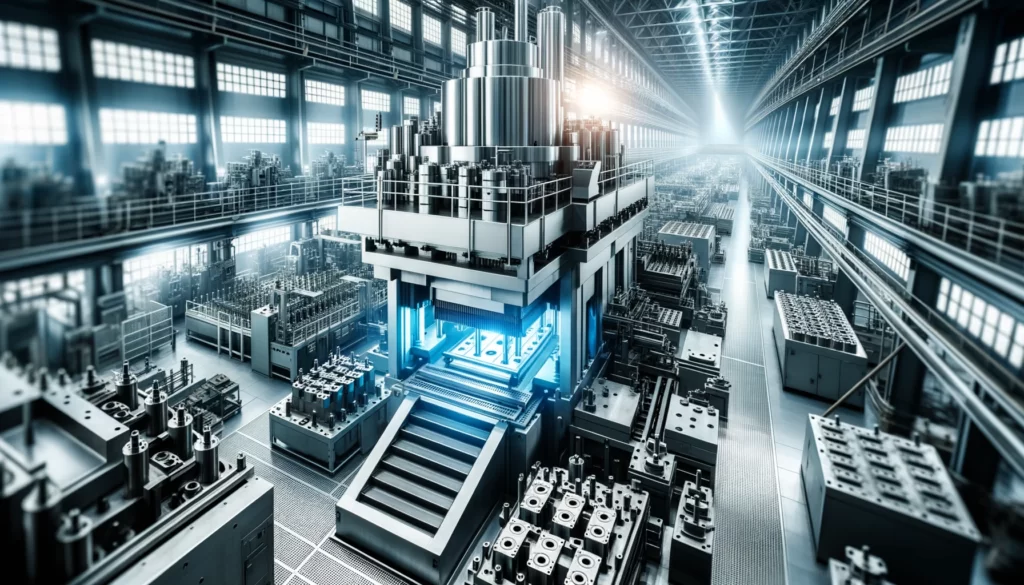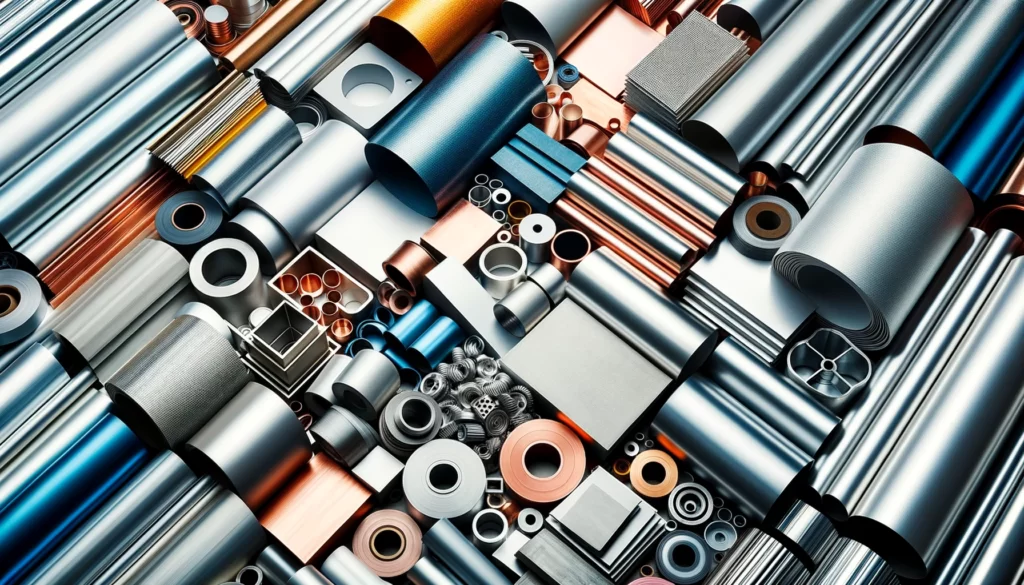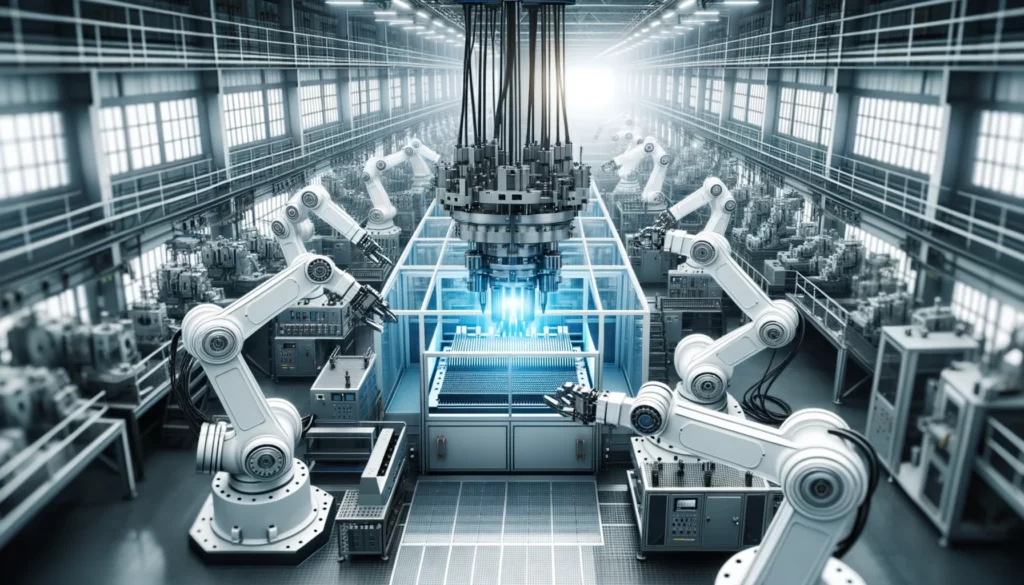Dive into the realm of deep drawing dies, an essential tool in the metal forming industry, to unravel their role in crafting complex, precision-driven components. As the demand for intricate metal parts escalates across various industries, understanding the core of deep drawing die technology becomes imperative.
Deep drawing dies are specialized tools used to shape metal sheets into complex forms through a process called deep drawing. This technology is pivotal in manufacturing durable, precision-engineered metal components across automotive, aerospace, and consumer electronics sectors.
Uncover the intricate design, functioning, and applications of deep drawing dies, and explore how advancements in this realm are fueling innovation in metal forming processes.

What are Deep Drawing Dies?
Deep drawing dies are specialized tools used within the metalworking industry to shape flat metal sheets into axi-symmetric and intricate three-dimensional parts through a process known as deep drawing. At its core, the process involves pulling or stretching a metal sheet, or “blank,” into a die by a mechanical punch. The die’s design is paramount as it dictates the final shape of the component, displaying a profound mastery over metal to create complex, precise forms.
From the ancient forges to today’s high-tech workshops, the art of deep drawing and die technology has journeyed through the ages. In its early days, it was but a fledgling craft, primitive yet full of potential. The industrial revolution, like a mighty wave, surged this craft forward, transforming it with unprecedented advancements in metalworking and die design. As we traversed through centuries, this technique evolved, not just in mechanics but in artistry. Today, the creation of deep drawing dies is not just a practice of engineering; it’s a dance of sophistication and innovation, a symphony of metallurgy and design principles perfected over time.
In the tapestry of modern innovation, the threads of computer-aided design (CAD) and computer-aided manufacturing (CAM) have woven a new era in the realm of deep drawing die creation. Like skilled artisans of the digital age, these technologies enable the crafting of dies with unprecedented precision. They transform complex blueprints into tangible realities, creating parts with such tight tolerances and exquisite finish that they seem more sculpted than manufactured. This journey from the hands of manual craftsmen to the bits and bytes of automated, digital fabrication is a testament to the colossal strides in technology. It’s a narrative of relentless advancement, pushing the frontiers of metal forming into realms once deemed unattainable.
Today’s deep drawing dies are a testament to the progression of metalworking technology. They play a pivotal role in various industries, enabling the production of components with complex geometries and high precision, which are crucial for modern-day applications in automotive, aerospace, consumer electronics, and beyond. The journey from simple hand-crafted dies to sophisticated, computer-designed tools illustrates the relentless pursuit of precision and efficiency in the manufacturing realm.

How Deep Drawing Dies Work?
The deep drawing process is a fascinating yet complex procedure that involves transforming a metal sheet into a three-dimensional object using a die and a punch. Here’s a step-by-step walkthrough of how this process unfolds, along with a closer look at the key components and materials employed in deep drawing dies:
The Deep Drawing Process:
- Metal Sheet Placement: Initially, a flat sheet of metal, often referred to as a blank, is placed over the die.
- Securing the Blank: The blank holder holds the metal sheet securely against the die to ensure precise drawing.
- Drawing: A mechanical punch, powered by a press, then descends and presses the metal into the die cavity, stretching and forming it into the desired shape.
- Ejection: Once the metal has been adequately formed, the punch retracts, and the newly formed part is ejected from the die.
- Inspection: The part is inspected for quality assurance, checking for any defects like splits or wrinkles, ensuring it meets the specified tolerances.
Key Components in Deep Drawing Dies:
- Die: The die is the cornerstone of the deep drawing process. It’s a hardened tool steel mold that defines the shape the metal sheet will assume. The die design is meticulously crafted to ensure precise forming and smooth ejection of the finished part.
- Punch: The punch, also made from hardened tool steel or other durable materials, applies the necessary force to press the metal into the die cavity.
- Blank Holder: The blank holder’s role is to keep the metal sheet in place during the drawing process, preventing wrinkles and ensuring a smooth draw.
- Press: The press, while not a part of the die per se, is integral to the process, providing the mechanical force required to drive the punch into the die.
Materials Used in Deep Drawing Dies:
- Tool Steel: Due to its exceptional hardness and wear resistance, tool steel is a common material choice for deep drawing dies.
- Carbide: For more demanding applications, carbide dies provide enhanced durability and longer service life, albeit at a higher cost.
- Coatings: Coatings like Titanium Nitride (TiN) or Diamond-Like Carbon (DLC) can be applied to the die and punch surfaces to reduce friction and wear, promoting smoother drawing and extended die life.
The orchestration of these elements, finely tuned through engineering expertise and high-quality materials, ensures the deep drawing process’s success, producing parts that meet the stringent demands of modern industries.

Importance of Material Selection in Deep Drawing Dies
Material selection is paramount in the realm of deep drawing dies, both for the construction of the dies themselves and the sheets being manipulated. Here’s a dive into the metals amenable to the deep drawing process and how material properties profoundly impact the process’s success:
Metals Amenable to the Deep Drawing Process:
- Steel: Steel, particularly stainless steel and cold-rolled steel, is frequently used due to its favorable combination of strength, ductility, and affordability.
- Aluminum: Aluminum’s allure lies in its lightweight nature and good ductility, making it a choice material for a variety of industries.
- Copper: Known for its excellent electrical conductivity, copper is also highly ductile, making it suitable for deep drawing.
- Brass: Brass shares many of copper’s favorable traits, with added strength, and is often used in electrical and decorative applications.
- Titanium: Although more expensive, titanium’s strength-to-weight ratio and corrosion resistance make it a viable option for more demanding applications.
Influence of Material Properties on Deep Drawing Success:
- Ductility: Ductility is the cornerstone of a successful deep drawing process. Materials that can withstand significant deformation without breaking are ideal candidates for deep drawing.
- Strength: While ductility is crucial, the material must also have enough strength to maintain its shape once formed.
- Thickness: The thickness of the material can affect the depth to which it can be drawn without failure. It also impacts the force required to draw the material.
- Friction Characteristics: Materials that generate less friction against the die and punch surfaces can lead to smoother drawing processes and less wear on the dies.
- Cost: Cost is always a consideration; materials that provide the required performance characteristics at a lower cost are often preferred.
- Coating Compatibility: Some materials may be coated to improve their surface finish or reduce friction during drawing. The compatibility of these coatings with the base material is vital.
The interplay between the material properties and the deep drawing process intricacies underscores the importance of judicious material selection. By aligning material attributes with the demands of the deep drawing process, manufacturers can significantly enhance the quality, efficiency, and cost-effectiveness of the production line, propelling their projects to success.

Design Complexities and Solutions in Deep Drawing Die Manufacturing
Designing deep drawing dies encapsulates a realm of complexities, each demanding meticulous attention and innovative solutions to ensure the manufacturing process runs seamlessly. Here’s a glimpse into the challenges and the advancements aiding in overcoming these hurdles:
Challenges Encountered in Designing Deep Drawing Dies:
- Achieving Desired Precision: The precision with which deep drawing dies are crafted directly impacts the quality of the final products. Achieving high precision while adhering to tight tolerances is a formidable challenge.
- Material Springback: Materials tend to revert back to their original form after being stretched or compressed, a phenomenon known as springback. This necessitates complex die designs to compensate for such behavior.
- Surface Finish: Ensuring a smooth surface finish on the drawn parts while avoiding defects like cracks, wrinkles, or tears is a significant challenge.
- Tool Wear: The dies undergo substantial wear and tear, demanding materials and designs that can endure these harsh conditions over extended periods.
- Cost Efficiency: Balancing between cost-effectiveness and achieving high-quality outcomes is a perennial challenge in die design.
Innovative Solutions and Technologies:
- Advanced CAD/CAM Systems: Utilization of sophisticated Computer-Aided Design (CAD) and Computer-Aided Manufacturing (CAM) systems facilitates precise design, simulation, and fabrication of deep drawing dies, minimizing errors and enhancing efficiency.
- Finite Element Analysis (FEA): Employing FEA helps in predicting the behavior of materials during the drawing process, enabling the design of dies that can effectively manage material springback and other deformation challenges.
- Surface Treatments and Coatings: Various surface treatments and coatings, like Diamond-Like Carbon (DLC) coatings, can be applied to the dies to reduce friction, enhance wear resistance, and improve the surface finish of the drawn parts.
- High-Speed Machining: High-speed machining technologies enable quicker and more accurate fabrication of dies, thus shortening lead times and reducing costs.
- Material Innovations: The advent of new, more durable materials for constructing the dies has been a boon, offering longer die life and better performance.
Through the amalgamation of innovative technologies, advanced materials, and refined design practices, the industry is steadily surmounting the design complexities inherent in deep drawing die manufacturing. This trajectory of continual innovation is pivotal in meeting the escalating demands for precision, efficiency, and cost-effectiveness in modern manufacturing landscapes.

Applications and Industries Benefitting from Deep Drawing Dies
Deep drawing dies play an indispensable role across a myriad of industries, aiding in the production of complex and precise metal parts. Below we delve into the pivotal sectors and present a glimpse of how deep drawing dies are driving real-world manufacturing narratives:
Pivotal Role in Key Industries:
- Automotive: Deep drawing dies are quintessential in crafting automotive parts like fuel tanks, fenders, and various other structural components. They enable the manufacture of complex geometries with high precision, catering to the stringent quality standards of the automotive sector.
- Aerospace: In the aerospace domain, where every gram and millimeter counts, deep drawing dies facilitate the production of lightweight yet robust components, enhancing fuel efficiency and safety.
- Consumer Electronics: The sleek metallic casings of smartphones, tablets, and other electronic gadgets are often crafted using deep drawing dies, which provide the requisite precision and aesthetic finish.
- Medical Devices: Deep drawing dies are instrumental in fabricating components for medical devices like casings for implantable devices, ensuring they meet the critical safety and hygiene standards.
- Food & Beverage Packaging: They also find utility in the creation of metal packaging materials, which require a high degree of hygiene and durability.
Case Studies Showcasing Impact:
- Automotive Fuel Tanks: A leading automotive manufacturer leveraged advanced deep drawing die technology to produce highly durable and precision-engineered fuel tanks, significantly enhancing the safety and fuel efficiency of their vehicle lineup.
- Aerospace Component Manufacturing: An aerospace company employed deep drawing dies in crafting lightweight structural components, contributing to a substantial reduction in the overall weight of the aircraft, thus leading to improved fuel efficiency.
- Consumer Electronics Casings: A renowned electronics manufacturer utilized deep drawing dies to achieve the sleek, seamless metallic casings for its premium smartphone range, which became a hallmark of the brand’s design ethos.
These real-world scenarios underscore the transformative impact of deep drawing dies across diverse industrial landscapes. The ability of deep drawing dies to deliver precision-engineered components cost-effectively is a cornerstone for the continual advancements witnessed in these sectors.

Quality Assurance and Standards in Deep Drawing Die Manufacturing
The manufacturing of deep drawing dies is a highly meticulous process, and adhering to stringent quality standards is imperative to ensure the functionality, durability, and safety of the produced components. Below we explore the international standards and quality assurance measures pivotal in deep drawing die manufacturing:
International Standards:
- ISO Standards: The International Organization for Standardization (ISO) has set forth several standards pertaining to the manufacturing of deep drawing dies. For instance, ISO 2768-1 outlines the general tolerances for linear and angular dimensions, while ISO 8062-3 delves into the dimensional tolerances for die-castings.
- ASTM Standards: The American Society for Testing and Materials (ASTM) also provides guidelines for the manufacture and testing of deep drawing dies. ASTM E8/E8M, for instance, is a standard for tension testing of metallic materials, which is crucial in assessing the performance of deep drawing dies.
- DIN Standards: The German Institute for Standardization (DIN) has specific standards like DIN 8588 which elaborates on the deep drawing process and associated tolerances, providing a framework for quality assurance in deep drawing die manufacturing.
Quality Control Measures:
- Material Testing: Ensuring the quality of materials used in the manufacturing of deep drawing dies is the first step towards quality assurance. This includes testing for tensile strength, elongation, and yield strength among other properties.
- Dimensional Accuracy Checks: Employing precision measuring instruments to verify the dimensional accuracy of the dies, ensuring they adhere to the specified tolerances.
- Surface Finish Assessment: Evaluating the surface finish of the dies to ensure they meet the required aesthetic and functional standards.
- Functional Testing: Conducting functional tests by actually employing the dies in a controlled environment to ascertain their performance and reliability.
- Regular Maintenance and Inspection: Implementing a regular maintenance schedule and conducting periodic inspections to ensure the dies remain in optimum condition and continue to meet the requisite quality standards.
The adherence to international standards and the deployment of rigorous quality control measures are fundamental in assuring the precision and reliability of deep drawing dies. These protocols not only ensure the functionality of the dies but significantly contribute to enhancing the overall efficiency and quality of the manufacturing process they are employed in.

Conclusion
Deep drawing dies are quintessential in modern manufacturing, enabling the precise forming of metals across numerous industries. Embracing technological advancements in this realm is instrumental for heightened precision and efficiency, steering metal forming endeavors towards success.


